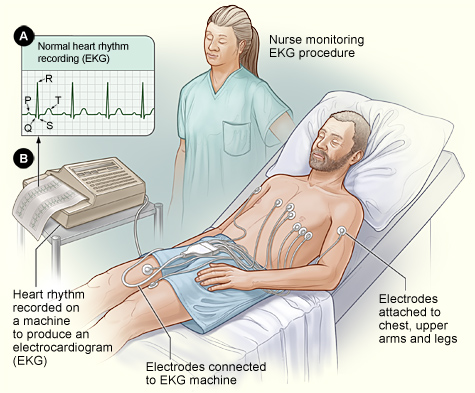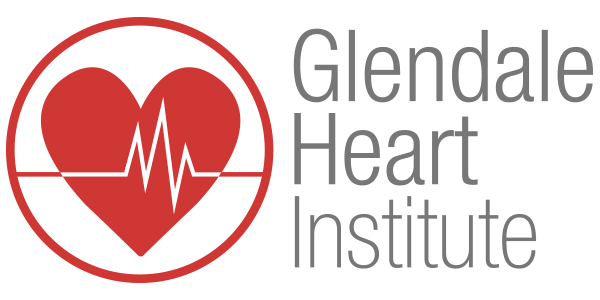An electrocardiogram is used to monitor your heart. Each beat of your heart is triggered by an electrical impulse normally generated from special cells in the upper right chamber of your heart. An electrocardiogram — also called an ECG or EKG — records these electrical signals as they travel through your heart. Your doctor can use an electrocardiogram to look for patterns among these heartbeats and rhythms to diagnose various heart conditions.
An electrocardiogram is a noninvasive, painless test. The results of your electrocardiogram will likely be reported the same day it’s performed, and your doctor will discuss them with you at your next appointment.
An electrocardiogram is a noninvasive, painless test. The results of your electrocardiogram will likely be reported the same day it’s performed, and your doctor will discuss them with you at your next appointment.
Why it’s done
An electrocardiogram is a painless, noninvasive way to diagnose many common types of heart problems. Your doctor may use an electrocardiogram to detect:
• Irregularities in your heart rhythm (arrhythmias)
• Heart defects
• Problems with your heart’s valves
• Blocked or narrowed arteries in your heart (coronary artery disease)
• A heart attack, in emergency situations
• A previous heart attack
Risks
An electrocardiogram is a safe procedure. There may be minor discomfort, similar to removing a bandage, when the electrodes taped to your chest to measure your heart’s electrical signals are removed. Rarely, a reaction to the electrodes may cause redness or swelling of the skin.
A stress test, in which an ECG is performed while you exercise or after you take medication that mimics effects of exercise, may cause irregular heartbeats or, rarely, a heart attack. These side effects are caused by the exercise or medication, not the ECG itself.
An electrocardiogram is a painless, noninvasive way to diagnose many common types of heart problems. Your doctor may use an electrocardiogram to detect:
• Irregularities in your heart rhythm (arrhythmias)
• Heart defects
• Problems with your heart’s valves
• Blocked or narrowed arteries in your heart (coronary artery disease)
• A heart attack, in emergency situations
• A previous heart attack
Risks
An electrocardiogram is a safe procedure. There may be minor discomfort, similar to removing a bandage, when the electrodes taped to your chest to measure your heart’s electrical signals are removed. Rarely, a reaction to the electrodes may cause redness or swelling of the skin.
A stress test, in which an ECG is performed while you exercise or after you take medication that mimics effects of exercise, may cause irregular heartbeats or, rarely, a heart attack. These side effects are caused by the exercise or medication, not the ECG itself.

There isn’t any risk of electrocution during an electrocardiogram. The electrodes placed on your body only record the electrical activity of your heart. They don’t emit electricity.
How You Prepare
No special preparations are necessary. However, avoid drinking cold water or exercising immediately before an electrocardiogram. Cold water can produce potentially misleading changes in one of the electrical patterns recorded during the test. Physical activity, such as climbing stairs, may increase your heart rate.
What You can Expect
An electrocardiogram can be done in the doctor’s office or hospital, and is often performed by a technician. After changing into a hospital gown, you’ll lie on an examining table or bed. Electrodes — often 12 to 15 — will be attached to your arms, legs and chest. The electrodes are sticky patches applied with a gel to help detect and conduct the electrical currents of your heart. If you have hair on the parts of your body where the electrodes will be placed, the technician may need to shave the hair so that the electrodes stick properly.
You can breathe normally during the electrocardiogram. Make sure you’re warm and ready to lie still, however. Moving, talking or shivering may distort the test results. A standard ECG takes just a few minutes.
If you have a heartbeat irregularity that tends to come and go, it may not be captured during the few minutes a standard ECG is recording. To work around this problem, your doctor may recommend another type of ECG:
• Holter monitoring. Also known as an ambulatory ECG monitor, a Holter monitor records your heart rhythms for an entire 24-hour period. Wires from electrodes on your chest go to a battery-operated recording device carried in your pocket or worn on a belt or shoulder strap. While you’re wearing the monitor, you’ll keep a diary of your activities and symptoms. Your doctor will compare the diary with the electrical recordings to try to figure out the cause of your symptoms.
• Event recorder. If your symptoms don’t occur often, your doctor may suggest wearing an event recorder. This device is similar to a Holter monitor, but it allows you to record your heart rhythm just when the symptoms are happening. You can send the ECG readings to your doctor through your phone line.
• Stress test. If your heart problems occur most often during exercise, your doctor may ask you to walk on a treadmill or ride a stationary bike during an ECG. This is called a stress test. If you have a medical condition that makes it difficult for you to walk, medication may be injected to mimic the effect of exercise on the heart.
After the procedure
Usually, your doctor will be able to tell you the results of your ECG the same day it’s performed. If your electrocardiogram is normal, you may not need any other tests. If the results show there’s a problem with your heart, you may need a repeat ECG or other diagnostic tests, such as an echocardiogram. Treatment depends on what’s causing your signs and symptoms.
How You Prepare
No special preparations are necessary. However, avoid drinking cold water or exercising immediately before an electrocardiogram. Cold water can produce potentially misleading changes in one of the electrical patterns recorded during the test. Physical activity, such as climbing stairs, may increase your heart rate.
What You can Expect
An electrocardiogram can be done in the doctor’s office or hospital, and is often performed by a technician. After changing into a hospital gown, you’ll lie on an examining table or bed. Electrodes — often 12 to 15 — will be attached to your arms, legs and chest. The electrodes are sticky patches applied with a gel to help detect and conduct the electrical currents of your heart. If you have hair on the parts of your body where the electrodes will be placed, the technician may need to shave the hair so that the electrodes stick properly.
You can breathe normally during the electrocardiogram. Make sure you’re warm and ready to lie still, however. Moving, talking or shivering may distort the test results. A standard ECG takes just a few minutes.
If you have a heartbeat irregularity that tends to come and go, it may not be captured during the few minutes a standard ECG is recording. To work around this problem, your doctor may recommend another type of ECG:
• Holter monitoring. Also known as an ambulatory ECG monitor, a Holter monitor records your heart rhythms for an entire 24-hour period. Wires from electrodes on your chest go to a battery-operated recording device carried in your pocket or worn on a belt or shoulder strap. While you’re wearing the monitor, you’ll keep a diary of your activities and symptoms. Your doctor will compare the diary with the electrical recordings to try to figure out the cause of your symptoms.
• Event recorder. If your symptoms don’t occur often, your doctor may suggest wearing an event recorder. This device is similar to a Holter monitor, but it allows you to record your heart rhythm just when the symptoms are happening. You can send the ECG readings to your doctor through your phone line.
• Stress test. If your heart problems occur most often during exercise, your doctor may ask you to walk on a treadmill or ride a stationary bike during an ECG. This is called a stress test. If you have a medical condition that makes it difficult for you to walk, medication may be injected to mimic the effect of exercise on the heart.
After the procedure
Usually, your doctor will be able to tell you the results of your ECG the same day it’s performed. If your electrocardiogram is normal, you may not need any other tests. If the results show there’s a problem with your heart, you may need a repeat ECG or other diagnostic tests, such as an echocardiogram. Treatment depends on what’s causing your signs and symptoms.
Cardiac Specialty Care
• Structural Heart Disease
• TAVR
• CardioMEMS (Heart Failure)
• PFO Closure
• TAVR
• CardioMEMS (Heart Failure)
• PFO Closure
• Coronary Intervention
• Complex Higher-Risk (And Indicated) Patients (CHIP) Angioplasty
• Atherectomy
• Impella and ECMO Support
• Complex Higher-Risk (And Indicated) Patients (CHIP) Angioplasty
• Atherectomy
• Impella and ECMO Support
• Peripheral Angioplasty
• Varicose Vein Treatment (Venous Ablation)
• DVT thrombectomy - IVC filter
• Carotid Stenting
• Varicose Vein Treatment (Venous Ablation)
• DVT thrombectomy - IVC filter
• Carotid Stenting
• Rhythm Management
• Pacemaker
• Holter Monitoring
• Exercise Stress Test
• Echocardiography
• Nuclear Stress Test
• Enhanced External Counterpulsation (EECP)
• Pacemaker
• Holter Monitoring
• Exercise Stress Test
• Echocardiography
• Nuclear Stress Test
• Enhanced External Counterpulsation (EECP)
